Stuttgart, Arkansas
Stuttgart is a city in and the county seat of the northern district of Arkansas County, Arkansas, United States. It is located on U.S. Route 165, approximately 45 miles (72 km) southeast of Little Rock; and on U.S. Route 79 approximately 110 miles west (and slightly south) of Memphis, Tennessee. Stuttgart is also on the Union Pacific Railroad between Memphis, Tennessee, and Pine Bluff, Arkansas. As of the 2010 census it had a population of 9,326.[5]
Stuttgart, Arkansas | |
|---|---|
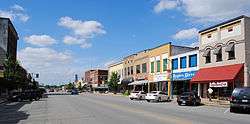 Downtown Stuttgart | |
| Nickname(s): "Rice and Duck Capital of the World"[1] | |
| Motto(s): "A Natural Place To Call Home"[2] | |
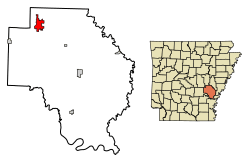 Location of Stuttgart in Arkansas County, Arkansas. | |
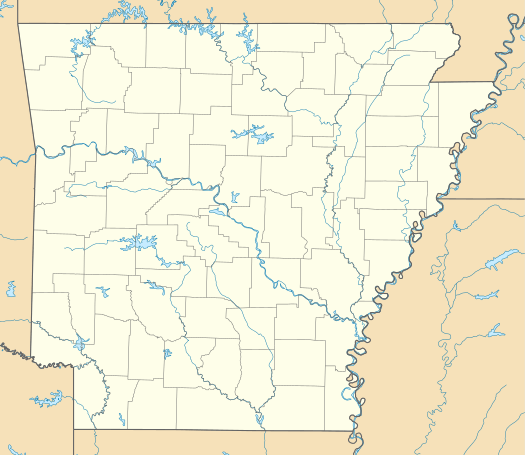 Stuttgart Location of Stuttgart in Arkansas and the US  Stuttgart Stuttgart (the United States) | |
| Coordinates: 34°29′49″N 91°33′3″W | |
| Country | |
| State | |
| County | Arkansas |
| Area | |
| • Total | 7.49 sq mi (19.40 km2) |
| • Land | 7.49 sq mi (19.40 km2) |
| • Water | 0.00 sq mi (0.00 km2) |
| Elevation | 210 ft (64 m) |
| Population (2010) | |
| • Total | 9,326 |
| • Estimate (2019)[4] | 8,490 |
| • Density | 1,133.21/sq mi (437.54/km2) |
| Time zone | UTC-6 (Central (CST)) |
| • Summer (DST) | UTC-5 (CDT) |
| ZIP code | 72160 |
| Area code(s) | 870 |
| FIPS code | 05-67490 |
| GNIS feature ID | 0058703 |
| Website | cityofstuttgartar |
| Stuttgart Arkansas Chamber of Commerce | |
History
Stuttgart was founded by Reverend Adam Bürkle,[6][7] a native of Plattenhardt in Germany. He moved to the United States in 1852 and founded a settlement at Gum Pond after living in Ohio. In 1880, he opened a post office and had thus to name the village. In honor of his home he named it after Stuttgart, then capital of the Kingdom of Württemberg.[1] In 1882, the Texas and St. Louis railroad was opened. Stuttgart became a city in 1884, and in 1904, rice farming was first introduced in the Stuttgart area. Stuttgart's first Postmaster General was a black man named Martin Toms, according to the US Census.
Geography
Stuttgart is located at 34°29′49″N 91°33′3″W (34.497043, -91.550917).[8]
According to the United States Census Bureau, the city has a total area of 7.2 square miles (18.7 km2), all land.[5] Hard clay underlying the area's topsoil makes Stuttgart a good place to grow rice, which grows best in flooded fields made possible by the clay. The geography is mainly flat with no outstanding mountainous features with the exception of "WBA Mountain", a small artificial mound located west of the city.
Demographics
| Historical population | |||
|---|---|---|---|
| Census | Pop. | %± | |
| 1910 | 2,740 | — | |
| 1920 | 4,522 | 65.0% | |
| 1930 | 4,927 | 9.0% | |
| 1940 | 5,628 | 14.2% | |
| 1950 | 7,276 | 29.3% | |
| 1960 | 9,661 | 32.8% | |
| 1970 | 10,477 | 8.4% | |
| 1980 | 10,941 | 4.4% | |
| 1990 | 10,420 | −4.8% | |
| 2000 | 9,745 | −6.5% | |
| 2010 | 9,326 | −4.3% | |
| Est. 2019 | 8,490 | [4] | −9.0% |
| U.S. Decennial Census[9] | |||
As of the 2010 United States Census, there were 9,326 people living in the city. 58.7% were White, 36.5% African American, 0.2% Native American, 0.7% Asian, 2.4% from other races and 1.4% from two or more races. 3.5% were Hispanic or Latino of any race.
As of the census[10] of 2000, there were 9,745 people, 3,994 households, and 2,731 families living in the city. The population density was 1,583.0 people per square mile (610.8/km2). There were 4,384 housing units at an average density of 712.2 per square mile (274.8/km2). The racial makeup of the city was 64.0% white or Caucasian, 34.5% black or African American, 0.6% Asian, 0.01% Pacific Islander, 0.2% Native American, 0.2% from other races, and 0.5% from two or more races. 0.8% of the population were Hispanic or Latino of any race.
There were 3,994 households, out of which 31.6% had children under the age of 18 living with them, 48.0% were married couples living together, 16.7% had a female householder with no husband present, and 31.6% were non-families. 28.4% of all households were made up of individuals, and 12.6% had someone living alone who was 65 years of age or older. The average household size was 2.40 and the average family size was 2.94.
In the city, the population was spread out, with 26.0% under the age of 18, 8.8% from 18 to 24, 26.0% from 25 to 44, 23.0% from 45 to 64, and 16.2% who were 65 years of age or older. The median age was 38 years. For every 100 females, there were 86.8 males. For every 100 females age 18 and over, there were 81.2 males.
The median income for a household in the city was $31,664, and the median income for a family was $39,126. Males had a median income of $30,860 versus $21,817 for females. The per capita income for the city was $16,490. About 13.8% of families and 18.2% of the population were below the poverty line, including 25.7% of those under age 18 and 17.3% of those age 65 or over.
Economy
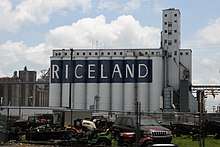
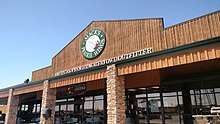
Stuttgart is home to Mack's Prairie Wings, known around the world as the premier waterfowl sports outfitter, through their store and online presence. During the third week in November (Thanksgiving Week), Stuttgart holds the World Championship Duck Calling Contest that brings in people of all ages from around the world to show off their talent using a duck call.
Riceland Foods, a farmer-owned agricultural marketing cooperative and world's largest miller and marketer of rice, headquarters are in Stuttgart.
Producers Rice Mill, another farmer-owned agricultural marketing cooperative that is also among the largest millers and marketers of rice is also headquartered in Stuttgart.
Lennox Industries, Stuttgart has a Lennox Air Conditioner factory.
Stratton Seed, Stuttgart is home to Stratton Seed, a large marketer of soybeans, and soybean seed.
Layne Arkansas, Stuttgart is home to Layne Arkansas, a business that installs water pumping wells to irrigate farms, and also installs city water systems.
Baptist Hospital, Stuttgart also has a branch of the Baptist Hospital Group which serves a large part of Arkansas. The Stuttgart Baptist Hospital is a central hospital for much of the surrounding region - - Arkansas County, Prairie County, Monroe County, Western Phillips, Northern Jefferson County, and Eastern Lonoke County. It is one of the largest employers in Stuttgart.
The University of Arkansas' Dale Bumpers Rice Research Center about seven miles east of Stuttgart employs a team of scientific researchers who breed new varieties of rice, and is one of the biggest employers in the area.
Delta Plastics of the South is a manufacturer of plastic irrigation tubes used for watering crops. These tubes are a replacement for more rigid plastic or aluminum pipe systems that used to be used to irrigate. One of Delta Plastics manufacturing plants is located in Stuttgart, and is a big employer in the area.
Climate
The climate in this area is characterized by hot, humid summers and generally mild to cool winters. According to the Köppen Climate Classification system, Stuttgart has a humid subtropical climate, abbreviated "Cfa" on climate maps.[11]
Education
Public education for elementary and secondary school students is primarily provided by Stuttgart Public Schools, which leads to graduation from Stuttgart High School.
Stuttgart also has Saint John's Lutheran Elementary School, and Holy Rosary Catholic Elementary School, and Grand Prairie Christian School.
Stuttgart also has a branch of Phillips County Community College, a two-year junior college (that also has campuses in Helena, Arkansas, and DeWitt, Arkansas), which is affiliated with the University of Arkansas system.
Arts and culture
Annual cultural events
There is an annual Wings Over The Prairie Festival every November, from Wednesday through Saturday, during Thanksgiving week. The festival features the World's Championship Duck Calling Contest, carnival rides, craft tents, and a Queen Mallard Pageant, all celebrating duck hunting which is Stuttgart's biggest tourist attraction.
There is an annual German Heritage Festival.
Stuttgart is home to the Museum of the Arkansas Grand Prairie which has displays celebrating the history of Stuttgart, and the surrounding Grand Prairie area.
There is also an annual Arts Festival held in the Grand Prairie Center on the campus of Phillips County Community College in Stuttgart.
Recreation
Many people in the Stuttgart area are big high school football fans, and can be found on Friday nights, in the Fall, supporting their Stuttgart Ricebirds high school football team which has won several Arkansas state championships during the last seventy-five years.
Stuttgart has a thriving adult softball league.
Stuttgart has the Rice Bowl Bowling Alley with bowling leagues.
Stuttgart has Open Season Bar & Grill, and Kelly's on Main St (bar & grill) which feature good food, and sometimes live bands, or karaoke nights.
The Grand Prairie Center on the campus of Phillip's County Community College in Stuttgart brings in performances by live bands, and stage plays a handful of times each year.
Infrastructure
Healthcare
Stuttgart and the surrounding area are served by Baptist Health Medical Center-Stuttgart, a 49-bed acute care facility.[12] The facility originally opened in 1957 under the name Stuttgart Memorial Hospital, then became Stuttgart Regional Medical Center. It took its current name in 2007 when it became part of the Baptist Health System based in Little Rock, Arkansas.
In popular culture

The 1989 movie Rosalie Goes Shopping, directed by Percy Adlon and starring Marianne Sägebrecht, was set in Stuttgart.
The city drew media attention during the sixth cycle of America's Next Top Model in the spring of 2006 when Stuttgart resident Furonda Brasfield was featured among the contestants.
A tornado that struck Stuttgart was featured on the November 9, 2008 episode of Storm Chasers on the Discovery Channel, including footage of the actual tornado was shot by Jeff Piotrowski of TwisterChasers.Com. The DOW-6 and TornadoVideos.net teams chased the Stuttgart storm into the town.
Some scenery in Stuttgart appears in the 2007 movie Shotgun Stories, starring Michael Shannon, directed by Jeff Nichols, which was also filmed in England, Arkansas and North Little Rock.
Some scenery in Stuttgart also appears in the 2012 movie Mud starring Matthew McConaughey and Reese Witherspoon, and directed by Jeff Nichols. Mud was also filmed around DeWitt, Dumas, and Casscoe.
Notable people
- Douglas A. Blackmon, Pulitzer Prize-winning author of Slavery by Another Name, born in Stuttgart
- Fonda Hawthorne, Democratic member of the Arkansas House of Representatives from Little River County; born in Stuttgart in 1956
- Oren O'Neal, Former NFL Fullback; Oakland Raiders Team Rookie of the Year 2007.
- John Dillon from the rock band Ozark Mountain Daredevils, who had the hits "Jackie Blue" and "If You Wanna Get to Heaven" during the 1970s, attended Stuttgart Public Schools.
- Scott Galloway, former Mississippi State baseball player and national high school duck-calling champion.
References
- "Profile for Stuttgart, Arkansas, AR". ePodunk. Retrieved September 12, 2012.
- "Stuttgart Arkansas Chamber of Commerce". Stuttgart Arkansas Chamber of Commerce. Retrieved September 12, 2012.
- "2019 U.S. Gazetteer Files". United States Census Bureau. Retrieved June 30, 2020.
- "Population and Housing Unit Estimates". United States Census Bureau. May 24, 2020. Retrieved May 27, 2020.
- "Geographic Identifiers: 2010 Demographic Profile Data (G001): Stuttgart city, Arkansas". U.S. Census Bureau, American Factfinder. Archived from the original on February 12, 2020. Retrieved May 1, 2013.
- "Answers - The Most Trusted Place for Answering Life's Questions". Answers.com. Retrieved September 17, 2017.
- "Stadt Filderstadt: Startseite". www.filderstadt.de. Retrieved September 17, 2017.
- "US Gazetteer files: 2010, 2000, and 1990". United States Census Bureau. February 12, 2011. Retrieved April 23, 2011.
- "Census of Population and Housing". Census.gov. Retrieved June 4, 2015.
- "U.S. Census website". United States Census Bureau. Retrieved January 31, 2008.
- "Stuttgart, Arkansas Köppen Climate Classification (Weatherbase)". Weatherbase. Retrieved September 17, 2017.
- "Baptist Health-Stuttgart". Baptist Health. Retrieved December 4, 2019.
External links
| Wikimedia Commons has media related to Stuttgart, Arkansas. |
- Stuttgart Chamber of Commerce
- Stuttgart 72160 Photos at TrekEarth
- "Stuttgart" at Arkansas.com
- "Stuttgart, Arkansas" at City-Data.com
- "Stuttgart" at Local.Arkansas.gov
- Stuttgart Daily Leader
- Stuttgart, Arkansas entry on the Encyclopedia of Arkansas History & Culture
- Baptist Health Medical Center - Stuttgart
- "Riceland Farmers" at Riceland.coop
- Riceland Foods" at Riceland.com
